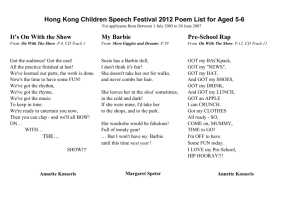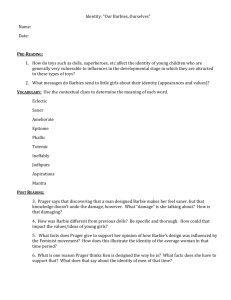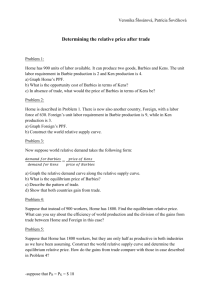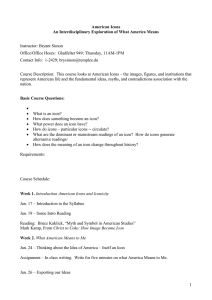Representation 2
advertisement
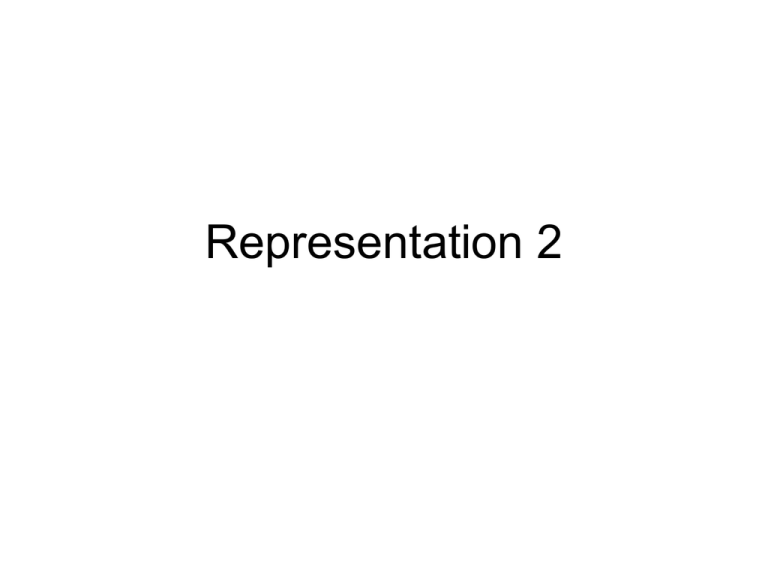
Representation 2 René Magritte: The Treachery of Images (1928-9) René Magritte: Two Mysteries (1966) Mise an abyme ‘put in an abyss’ . Infinite regression On your breakfast table is your packet of cornflakes, and on your packet is a picture of the smiling Kellogg family at breakfast, and on their table is a picture of your packet which has a picture of the smiling Kellogg family, and so on (M. Ashmore) e.g. Hamlet: the ‘mousetrap scene’ Midsummer Night’s Dream: the play of the ‘rude machanicals’ • Re-presentations: we think that the model (‘reality’) precedes, pre-exists the representation Representations and schemata • Do we represent what we see? Magritte: The Uses of Speech Magritte: The Interpretation of Dreams Alain: „Egyptian life class”, 1955 Relief of the divine birth of Hatshep sut Gentile da Fabriano: Adoration of the Magi (1322-3) Rubens: Adoration of the Magi (1633) Power of representations ‘society of the spectacle’ (Guy Debord) Images replace what we see Emile Zola: “I don’t think we can claim that we have seen something until we have not photographed it” Magritte: The Human Condition Andy Warhol: Marilyn (green) 1960s Andy Warhol: Marilyn (pink) 1960s Warhol’s pictures • • • • • no ‘realism’ cheap, poor quality, mass-produced image face – soul the body is well-known public property: an image where the soul should be Claude glass - Thomas Gainsborough Tintern Abbey through a Claude glass Claude glass • • • • • Named after Claude Lorrain Small portable mirror tinted with dark foil Recommended to 18th-century painters picturesque effect the very idea of ‘landscape’ Tintern Abbey Technologies of representation • New technologies change our views of representation itself and of the mind (camera obscura; ‘photograhic memory’) • They change what we (can) see and how we see Prosthetic images • we could not see these things otherwise • Microscope was called by Richard Hooke, its inventor, an „artificial organ” (1665), that ‘supplies the infirmities’ of the natural • How can we check images of the ‘invisible’? 19th-century cartoon about the microscope the dark side of the moon Mrs. Röntgen’s hand embryo scan M. C. Escher: Relativity • M. C. Escher: Waterfall analog and digital images • digital vs analog technologies of making images • Digital images stored as data • ‘represent’ a matrix rather than an image • Images are generated the hyperreal • HYPERREAL: ‘the generation by models of of a real without origin in reality’ (Jean Baudrillard) • images that are not representations • generated by formulas, algorithms cyberspace • “I looked into one of the video arcades. I could see in the physical intensity of their postures how rapt the kids were…These kids clearly believed in the space games projected. Everyone I know who works with computers seems to develop a belief that there’s some kind of actual space behind the screen, someplace you can’t see but you know is there.” (William Gibson: Neuromancer) Barbie dolls Barbie doll • Originally designed as a fashion doll for adults (Mattel, 1959) • Teaches fixed, normative gender roles to girls (codes of femininity: defined through the body, standards of dress and behaviour • ‘Barbie is a consumer. She demands product after product, and the packaging and advertising imply that Barbie, as well as her owner, can be made happy only if she wears the right clothes and owns the right products” (Marilyn Ferris Motz) Barbie/2 • multicultural Barbies: same body (racial difference ) • ethnic, aerobic, fitness phases • female body as ‘cultural plastic’ • desexualised in detail • over-eroticised in general outlines • impossible body Sindi (Cindy) Jackson: Living Doll Valeria Lukyanova human Barbie Technologies of the body • You can shape your body into whatever you want it to be • Elastic body: transformer • Barbie and human Barbies as ‘posthuman’ SIMULACRUM e.g. Somehuman Barbies: thing modelled on an image that has no original Tasaday tribe (Philippines) • Disneyland • “Disneyland is there to conceal the fact that it is the ‘real’ country, all of ‘real’ America, which is Disneyland … Disneyland is presented as imaginary to make us believe that the rest is real, when in fact all of Los Angeles and the America surrounding it are no longer real, but of the order of the hyperreal and of simulation.” (Baudrillard) William Wallace monument Braveheart Paul Foelsche: Lialloon (1879, New Guinea) anthropometry Anthropometry, „Bertillonage” Alphonse Bertillon, Prefect of Paris Police (late 19th century) ‘Lialloon’ - The photo constructs ‘us’ as its makers and beholders - us= civilised, modern Europeans - possessing the ‘scientific gaze’ What does ‘Lialloon’ represent? - Lialloon: not an individual - provides ‘objective knowledge’ (photography is ‘true’) - (1) image of ‘barbarity’ for us (an ‘other’) – Barbarity, primitivism: - (2) ‘noble savage’ (touched up with charcoal) - (3) potential criminal (Foelsche: colonial administrator) - allegory of ‘race’ The politics of representation • „politics” = power is involved • Who has the right (power) to represent something? Who tells the story of extinct peoples? history written by the winners technological inequality James Bond: Roger Moore or Sean Connery posters of Dr. No (1962) Pierce Brosnan / Daniel Craig • “He was a comely handsome fellow, perfectly well made; with straight strong limbs, not too large; tall and well shaped … He had a very good countenance, not a fierce and surly aspect; but seemed to have something very manly in his face, and yet he had all the sweetness and softness of an European in his countenance too, especially when he smiled. His hair was long and black, not curled like wool… The colour of his skin was not quite black, but very tawny; and yet not of an ugly yellow nauseous tawny, as in the Brasilians, but of a bright kind of a dun olive colour, that had in it something very agreeable, though not very easy to describe.” (Defoe: Robinson Crusoe, 1719) Robinson Crusoe and Friday Robinson Crusoe and Friday 2 Bronislaw Malinowski Bronislaw Malinowski among the Trobriand Islanders (1918) Malinowski’s diary (1918) • “At 5 I went to Kaulaka. A pretty, finely built girl walked ahead of me. I watched the muscles of her back; her figure, her legs, and the beauty of the body so hidden to us, whites, fascinated me. Probably even with my own wife I’ll never have the opportunity to observe the play of back muscles for as long as with this little animal. At moments I was sorry I was not a savage and could not possess this pretty girl. At Kaulaka, looked round, noting things to photograph.” • „America was invented before it was discovered” (Giuseppe Cocchiara) • „Who controls the past controls the future. He who controls the present controls the past.” (Orwell: Nineteen Eighty-Four + ADF’s ‘Memory War’) Politics of representation • Representations: political practices, sites of conflict and resistance • Representations can be changed, revised • Jean Rhys: Wide Sargasso Sea (madwoman’s story in Jane Eyre) • J. M. Coetzee: Foe (Friday and Susan Barton) • Michel Tournier: Friday or the Ends of the Pacific Friday (French film, 1981)
